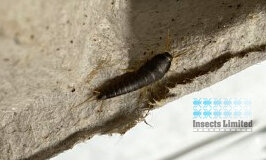Silverfish Common (Lepisma saccharina)
Silverfish are placed in the order Thysanura which is considered one of the most primitive of the living insect orders. Though most are generally cosmopolitan in distribution, the Gray Silverfish is found in the Midwest to California and South.
Presence of either silverfish indicate a warm humid environment. Silverfish prefer slightly environments of 72 to 80 degrees F. Adverse to light, they tend to be found in dark areas of suitable climate with an abundant supply of food.
However, their presence at a feeding site not warm or humid may indicate a nearby preferred microclimate. The color of different species can vary.



Common Silverfish Life Stages
Adults: Up to 12.5mm (0.5inches) long with a flattened fish or carrot shaped outline. Long segmented antennae. Body covered in scales. 3 tail-like appendages.
Egg: Yellowish white hue.
Immature Stage: Nymphs appear as young adults. Scales do not appear until after the third molt.
Silverfish Life Cycle
Adult silverfish can live for 2 - 3.5 years. Eggs hatch in 19 to 45 days in warmer months. The immature silverfish, or Nymph will stay in this stage for 3 to 4 months. Sexual maturity is reached in a few moths and with a high birthrate, the silverfish can reach enormous infestation potential.
Damage & Detection
Damage from silverfish on paper products is often characterized by ragged scraped areas and irregular holes. Damage to textiles is indicated by the presence of feces (described as small, dark, and visible to the naked eye), scales (visible with a hand lens), and ground fibers. A yellow stain is often apparent at the damaged area.
Silverfish Fun Facts
There are four species considered common in North America; the Firebrat (Thermobia domestica), the Common Silverfish (Lepisma saccharina), the Gray or Longtailed Silverfish (Ctenolepisma longicaudata), and the Four-Lined Silverfish (Ctenolepisma quadriseriata).
What They Eat
Silverfish and firebrats are particularly fond of starch and items containing starch. They can often be found feeding on wallpaper and its adhesive paste as well as glazed paper, as both have a high starch content. They are also reported to feed upon other paper products, book bindings, textiles, cotton, silk and other glues.
How to Control Silverfish
Silverfish thrive in warm moist environments. Climate control in terms of reducing humidity and lowering temperature can cause populations to decline significantly. Also controlling nearby micro-environments where pests can migrate from is important. Controlling food sources such as removing cardboard boxes and removing paper products not part of a collection is advised.
It is also recommended whenever possible that books and documents be placed in sealed containers. Cleaning around bookcases in cracks and crevices with a HEPA vacuum and sealing afterward can reduce potential breeding habitat.
